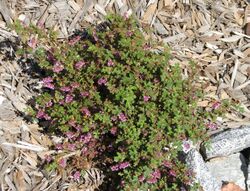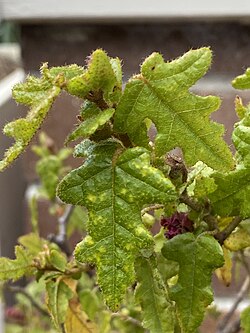Biology:Thomasia quercifolia
| Oak-leaf thomasia | |
|---|---|

| |
| Scientific classification | |
| Kingdom: | Plantae |
| Clade: | Tracheophytes |
| Clade: | Angiosperms |
| Clade: | Eudicots |
| Clade: | Rosids |
| Order: | Malvales |
| Family: | Malvaceae |
| Genus: | Thomasia |
| Species: | T. quercifolia
|
| Binomial name | |
| Thomasia quercifolia (Andrews) J.Gay[1]
| |
| Synonyms | |
|
Lasiopetalum quercifolium Andrews | |
Thomasia quercifolia, commonly known as oak leaved thomasia,[2] is a flowering plant in the family Malvaceae and is endemic to the south-west of Western Australia. It has egg-shaped, lobed leaves with a heart-shaped base, and pink to mauve flowers.
Description
Thomasia quercifolia is a densely-branched, low shrub that typically grows to 10–30 cm (3.9–11.8 in) high and 80–100 cm (31–39 in) wide, the stems covered with rust-coloured, star-shaped hairs. The leaves are egg-shaped with a heart-shaped base, 7–30 mm (0.28–1.18 in) long and 10–25 mm (0.39–0.98 in) wide, on a petiole up to 12 mm (0.47 in) long. The leaves usually have 5 lobes, the lobes often further or toothed. Both surfaces of the leaves are covered with star-shaped hairs, more densely so on the lower surface. The flowers are arranged in groups of 2 to 8 on a raceme usually up to 30 mm (1.2 in) long on a hairy peduncle 8–10 mm (0.31–0.39 in) long with hairy, linear bracteoles 3–5 mm (0.12–0.20 in) long at the base of each flower, the flowers 5–8 mm (0.20–0.31 in) in diameter. The sepals are pink to mauve with a few coarse hairs. Flowering occurs from August to December.[2][3][4]
Taxonomy and naming
The species was first formally described by botanist Henry Cranke Andrews in The Botanist's Repository for New and Rare Plants in 1806. He gave it the name Lasiopetalum quercifolium Jaques Étienne Gay transferred the species to the genus Thomasia in 1861 as Thomasia quercifolia.[5] The specific epithet (quercifolia) means "oak leaved".[6]
Distribution and habitat
Oak leaved thomasia grows in coastal heath over limestone near the south coast of Western Australia, between the Walpole-Nornalup National Park and Bremer Bay in the Jarrah Forest and Warren bioregions of south-western Western Australia.[3][2][4]
Conservation status
Thomasia quercifolia is listed as "Priority Four" by the Government of Western Australia Department of Biodiversity, Conservation and Attractions,[2] meaning that it is rare or near threatened.[7]
References
- ↑ "Thomasia quercifolia". Australian Plant Census. https://biodiversity.org.au/nsl/services/apc-format/display/65933.
- ↑ 2.0 2.1 2.2 2.3 "Thomasia quercifolia". FloraBase. Western Australian Government Department of Parks and Wildlife. https://florabase.dpaw.wa.gov.au/browse/profile/5096.
- ↑ 3.0 3.1 Blake, Trevor L. (2021). Lantern bushes of Australia ; Thomasias & allied genera : a field and horticultural guide. Victoria: Australian Plants Society, Keilor Plains Group. pp. 54–55. ISBN 9780646839301.
- ↑ 4.0 4.1 Bentham, George (1863). Flora Australiensis. London: Lovell Reeve. p. 252. https://www.biodiversitylibrary.org/item/3669#page/310/mode/1up. Retrieved 29 August 2022.
- ↑ "Thomasia quercifolia". Australian Plant Name Index (APNI), IBIS database. Centre for Plant Biodiversity Research, Australian Government. http://www.anbg.gov.au/cgi-bin/apni?taxon_id=11427.
- ↑ Sharr, Francis Aubi; George, Alex (2021). Western Australian Plant Names and Their Meanings (4th ed.). Kardinya, WA: Four Gables Press. p. 299. ISBN 9780958034180.
- ↑ "Conservation codes for Western Australian Flora and Fauna". Government of Western Australia Department of Parks and Wildlife. https://www.dpaw.wa.gov.au/images/documents/plants-animals/threatened-species/Listings/Conservation%20code%20definitions.pdf. Retrieved 12 February 2023.
Wikidata ☰ Q7795566 entry
 |




